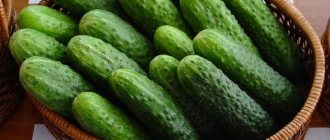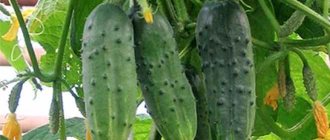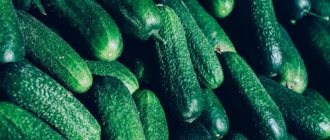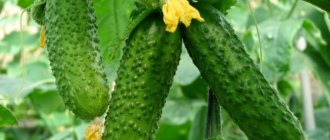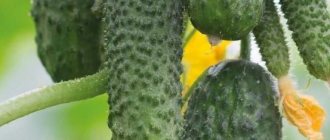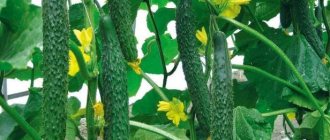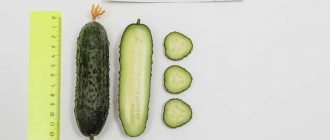The Mother-in-law F1 cucumber, despite its demanding nature and the need for regular care, has become popular in domestic gardens. This is due to the high taste and excellent presentation of the fruit, which ensures constant consumer interest in commercial sales.
Cucumbers of this variety are also good when used in the household. Fragrant fruits crunch loudly in summer salads. And the canned gifts of sunny summer will delight you with their dense pulp and impeccable shape.
History of selection
This hybrid was bred by breeders from a Russian breeding company at the beginning of this century. After the tests, the variety was included in the State Register of Russia in 2007.
The authors and originators of the variety are the following specialists:
- A. E. Portyankin;
- S. F. Gavrish;
- A. V. Shamshina;
- V. N. Shevkunov.
The Tesha cucumber variety is zoned for cultivation in the following Russian regions:
- Central;
- Srednevolzhsky;
- Severny;
- North-West;
- North Caucasus;
- Central Black Earth;
- Volga-Vyatka.
Mother-in-law cucumber can be grown in open ground and in film greenhouses.
How to choose a variety?
Cucumbers can be divided into bee-pollinated and self-pollinated. This is a heat-loving plant, which is often grown in film greenhouses. Parthenocarpic plants are suitable for cultivation in protected soil conditions. When choosing seed material for this vegetable crop, you should give preference to hybrids. They are the ones who are able to provide a good and high-quality harvest. Compared to varieties, they are more resistant to major diseases.
Among hybrids, attention has recently been paid to universal-purpose cucumbers with bunch-shaped ovaries. They are characterized by high yield and excellent quality of fruit. The “mother-in-law” and “son-in-law” cucumbers have proven themselves to be quite good. Reviews from gardeners emphasize that these hybrids are stable and indispensable for growing in film greenhouses.
Description of the cucumber variety Mother-in-law F1
The Teshcha cucumber hybrid is classified as an early-ripening variety - up to 1.5 months can pass from the moment the crops germinate until the first greens begin to ripen. The Mother-in-law cucumber is classified as a parthenocarpic type; only female-type flowers are formed on the vines.
The lashes have good growth vigor, can reach a height of more than 1.5 m, the formation of lateral shoots is average. Foliage is formed on the stems in sufficient quantity; it is quite large and bright green in color.
Up to 4 ovaries can form in each sinus. The shape of ripe greens is cylindrical, gherkin type, length is up to 15 cm, weight of Mother-in-law cucumbers is 110-120 g.
The diameter in cross section is no more than 4.0 cm. The skin is dense, crispy, covered with small tubercles and brown thorns. The pulp is dense, tasty, and has no voids.
On a note! The main distinguishing feature of the Teshcha hybrid is the absence of bitterness in the fruits even when overripe.
The harvested crop can be transported to different distances, while the greens do not lose their beautiful appearance and taste. Ripe cucumbers can be stored in the refrigerator for quite a long time.
Mother-in-law cucumber greens are distinguished by their versatility of use - they are used for fresh consumption, in salads and snacks, canned, and salted.
The fruits tolerate heat treatment well, no voids are formed in them, and a slight crunch remains. For pickling and pickling, you can pick cucumbers at the gherkin stage.
Description of fruits
The beginning of fruiting of Mother-in-law cucumbers occurs on average 44-48 days after full germination. Zelentsy are harvested at the stage of pickles (with a length of up to 5 cm), gherkins (with a length of up to 9 cm) or when they have reached technical maturity (with a length of 11-13 cm and a weight of 100-120 g). The fruits have a smooth, attractive appearance, are cylindrical in shape, dark green in color with short blurry light stripes. The surface is covered with medium-sized tubercles, loose white or brown pubescence.
The pulp of Mother-in-law cucumbers is strong, crispy, juicy and aromatic, the peel is thin, the seed chambers are small. Zelentsy have high taste qualities, without bitterness. They are used as fresh salad vegetables and are suitable for all processing methods: pickling and pickling.
Greens of this hybrid, when preserved, perfectly retain a distinct crunch and dense structure; no voids are formed inside.
Photo
Composition, benefits, calorie content
Cucumber Mother-in-law F1, like its brothers, consists of 95% structured water. There are other elements in the composition:
- beta-carotene;
- vitamins of all groups;
- minerals;
- cellulose.
Fresh cucumbers have a number of beneficial properties for the body: improving intestinal function, a beneficial effect on the thyroid gland, preventing the formation of cholesterol plaques, and a general tonic effect. This is one of the lowest-calorie products - 100 g of vegetable contains only 15 kcal.
Application
Hybrid Mother-in-law F1 has excellent taste, crispy and aromatic flesh. These cucumbers are used fresh and lightly salted, for salads and pickling. As a result of canning, no voids are formed in them. Preparations can be made from gherkins of this variety by picking cucumbers from 5 to 8 cm long. Such pickles can be stored well all winter without exploding. They are suitable for preparing delicious okroshka in the winter. You can freeze the fruits whole and grate them into a dish without defrosting, using a coarse grater.
Freshly picked cucumbers can be pickled immediately. They also keep well in the cold for about 5-7 days. However, they should be washed first and, without drying, wrapped in a bag. In this case, before canning, the fruits must be kept in cool water for 8 hours, changing it to new water every two hours.
Distinctive features
This is an early-ripening parthenocarpic hybrid: greens ripen within 45-50 days after germination, and the participation of insects is not required for fertilization. Farmers are attracted by the hybrid’s unpretentiousness, high yield and resistance to many vegetable diseases. The culture is immune to powdery mildew and peronospora.
Hybrid characteristics
Mother-in-law is a universal hybrid that is distinguished by extended and abundant fruiting. One ovary can produce 2-3 flowers. From one bush you can harvest 5-6 kg of cucumbers. The variety is suitable for cultivation in open and closed ground. It is also distinguished by its universal purpose, since the harvested crop is suitable for consumption fresh, pickled and salted.
Mother-in-law is an early-ripening hybrid variety that is valued by gardeners due to the lack of bitterness in green vegetables. Moreover, even overripe cucumbers do not have it. Since flowering is predominantly female, there is no need for insects for pollination.
The fruits are cylindrical in shape, their diameter is 4 cm, and their length is 11-13 cm. There are thorns and tubercles on the surface. The variety is high-yielding, and the first fruits can be collected within 45 days from the moment the seeds germinate. Plants are resistant to some diseases, one of which is powdery mildew.
Table: Main characteristics
Main characteristics of the cucumber variety Tescha
| Part | Description |
| Bush | A powerful plant with large dark green leaves, an average level of branching, indeterminate (tall) bushes, up to three ovaries in each axil. |
| Fruit | Dark green color, faintly traced whitish stripes, regular cylindrical shape, small spines and pimples present. Length – 11-13 cm, weight – 100-150 g, small seeds. |
| Taste qualities | The pulp is dense, homogeneous, juicy, there are no voids, there is no bitterness. |
| Productivity | The maximum yield from one bush is up to 7 kg. Productivity per 1 sq. m – up to 12 kg. |
Harvesting
In open ground, the first cucumbers ripen in early August. With proper planting and care of Mother-in-law f1 cucumbers, you can collect up to 6 kg of fruit (10-12.2 kg per 1 m²) from one bush. The duration of the fruiting period is 45-53 days. In the greenhouse, the first fruits can be tasted already in mid-June.
The harvest is harvested in good weather, and the fruits are placed in baskets or buckets. Due to their elasticity, fruits do not lose their shape during transportation; they are transported in wooden or plastic boxes or cardboard boxes.
Features of agricultural technology
In most Russian regions, the Tesha cucumber hybrid is grown by seedlings. Soil for planting can be purchased in specialized stores, or you can prepare it yourself by mixing humus, peat and river sand in equal proportions. Wood ash is also added to this nutrient substrate.
Since cucumbers do not tolerate transplanting and picking well, seeds for seedlings should be immediately planted separately in plastic or peat cups.
Some vegetable growers plant Mother-in-law cucumber seeds in peat tablets, along with which the grown seedlings are planted in a permanent place.
During growth, seedlings need to be watered as the top layer of soil dries out; cucumber plants need to be fed a couple of times before transplanting into open ground. As the first feeding, you can use a urea solution. This fertilizer is applied when the cucumbers have their first true leaf. The second feeding is carried out approximately two weeks before transplanting the Mother-in-law cucumbers to a permanent place, or 10-12 days after transplanting.
This is interesting: Growing cucumbers: care, feeding, watering, pinching and harvesting rules.
12-14 days before transplanting Mother-in-law cucumber seedlings into open ground, the seedlings need to be hardened off.
To do this, first, containers with plants are taken out into the fresh air for an hour and a half, gradually increasing the time the seedlings stay. In the last days before transplanting, containers with seedlings should be left in the fresh air not only during the day, but also at night.
Mother-in-law cucumber seedlings are transplanted into open ground beds or greenhouses when at least 4 permanent leaves appear on them (usually this happens in late May - early June).
The place for planting cucumber seedlings is prepared in advance. In regions with a cool climate, it is recommended to prepare warm beds in which cucumbers will feel more comfortable.
Advice! When preparing a plot for cucumbers, compost or humus should be added to digging in the fall (about 6 kg of organic matter for each square of area). In highly acidified soil, lime should also be added to deoxidize it.
If the groundwater on the site is located too close to the surface of the earth, then you need to prepare high beds with a drainage layer.
You need to add superphosphate and potassium salt to the prepared wells (15 g in each well). Cucumber seedlings in peat pots or tablets are planted in beds along with containers. And the seedlings are taken out of plastic cups along with a lump of earth, so as not to injure the delicate root system.
The distance between neighboring plants should be at least 50 cm, the distance between rows should be about 0.5 m.
After planting, Mother-in-law cucumbers are watered and, if necessary, covered with polyethylene to protect the tender seedlings from night frosts.
Care
The entire growing season will require special attention to bunch-type cucumbers. In order to get as many juicy, crispy gherkins as possible from numerous ovaries, a special growing regime will be required. This includes regular watering and fertilizing. Warm water is used to moisten the soil. Drying out the soil cover can be detrimental to the ovary. After moistening the soil, loosening and mulching are carried out.
At the beginning of flowering, watering is carried out every three days. Feeding is done every week. One square meter of cucumber bed requires at least twenty grams of complex mineral fertilizer. In addition, you can use a solution of bird droppings in a ratio of 1:20, or mullein in a ratio of 1:10.
Planting cucumbers Mother-in-law F1
Mother-in-law f1 cucumbers can be grown in two ways - through seedlings or by directly planting seeds in open ground. Moreover, the rate of formation of the first shoots will be directly related to the temperature readings:
- at temperatures below 13 degrees Celsius, planting material will not germinate;
- at a temperature of 15-20 degrees Celsius, seedlings form no later than 10 days;
- when the temperature is 25 degrees Celsius, seedlings appear on the 5th day.
Gardeners should choose the “golden mean” and provide the planting material with a temperature regime of up to 20 degrees Celsius. Then the shoots appear early and hardened.
Deadlines
At the end of April, Mother-in-law F1 cucumber seeds are sown to obtain seedlings. To do this, you can use special containers with soil, cups or peat tablets. Some vegetable growers set aside beds for sowing in temporary or permanent greenhouses. In the last ten days of May, and in the central and southern regions already from May 15, the grown seedlings are transferred to open ground.
In the northern regions there are sometimes spring frosts even at the very end of the month. Therefore, the tender sprouts of the Teshchaf1 cucumber are covered with plastic wrap. At the ends it is pressed to the ground with boards or bricks. Sometimes the need for such shelter continues until June 10-15. In this case, the film is raised for the day and lowered again for the night.
Growing seedlings
Plants grown from seedlings acclimatize faster in the garden, have good resistance to common diseases of vegetable crops and produce greater yields.
Seed preparation
Before sowing, the seeds of cucumbers of the Teshcha F1 variety are disinfected. To do this, prepare a 1% solution of potassium permanganate (1/3 teaspoon of powder per 200 ml of water), in which the seed is soaked for 20-30 minutes. Wash with plenty of water.
Important! When creating the hybrid Mother-in-law F1, seeds of the first generation were used, as indicated by the f1 index in the name of the variety. Therefore, independently collected seeds lose their quality. Planting material with good germination can be purchased in specialized stores.
Growing container
Almost any container is suitable for sowing cucumber seeds. This can be a small plastic box, separate plastic boxes or special cassettes with separate wells. Peat pots are also a good option for placing seeds, but they are not necessary. If seedlings have already been grown in a container before, then it should be scalded before reuse.
Sowing
A few days before starting work, it is necessary to prepare the soil mixture and fill the containers. Typically, limed peat, humus and turf are used to normalize acidity. Sometimes the soil for seedlings is fertilized with mullein. The components of the soil mixture are mixed in proportions - 6:1:2:1. When sowing, leave 3-5 cm between individual seeds.
Seedling care
During the day the temperature is in the range of 20-25°, at night it can drop to 15-19°. The humidity in the room should reach 60-70%. Usually, a container of water is placed next to the boxes with seedlings. It should be remembered that this hybrid variety of cucumbers needs a lot of light.
general information
Cucumber son-in-law
Bred in Moscow, in the company Gavrish. It is best to sow and cultivate in the Central, North Caucasus, and Middle Volga regions . Suitable for both cultivation on the ground and in greenhouse conditions. Their fruiting period is 43–48 days.
It has an unlimited period of growth of its stem, which is good for greenhouses, in which up to 50 bunches of fruitful fruits can grow. Flowering type: female, leaves of medium size. The skin is not only delicate, but also has light stripes. Mild taste, without bitterness.
The hybrid recovers well from illnesses and tolerates them well. Resistant to root rot . If the harvest is not harvested on time, the fruits take on a barrel-shaped appearance. If preparations are needed, then it is worth collecting at the gherkin stage or lower - at the pickle stage. Universal variety.
Son-in-law and Mother-in-law
Seeds should be sown towards the end of April , and transferred to the ground after the seedlings have grown, in May - June, at the time the leaves appear.
The advantages include:
- great taste;
- high yield;
- resistance to diseases.
Disadvantages:
- high price of seeds.
Reviews from fans:
I try to grow this type of cucumber using a net. As soon as they sprout, I tie them to the net and give them the right direction to grow. I drive large sticks into the ground, tie a rope to their end, and attach a net to the ropes. It is a pleasure and joy to look after your “son-in-law”: the fruits he produces are all visible, watering does not cause any worries. I did not form the plants, either varietal or hybrid, so when they lie, they do not receive enough heat and light. With the vertical method, the plants are ventilated very well and there are no problems with their diseases. Try it yourself, start experimenting. Natalia Siverina
Cucumber mother-in-law
It not only has a female type of flowering, but is also a fairly early ripening variety . Fruiting time after sunrise is 48 days. It can be grown both in the ground and in greenhouses.
It is best to plant cucumber seedlings towards the end of March or early April. It needs to be replanted into the ground or greenhouse in early June, by which time it should have 4 leaves.
The final size of the fruit is 13 centimeters. It has about 4 ovaries per leaf and there are spines and tubercles on the skin. This variety of cucumbers is resistant to disease and cold, and can be eaten immediately after picking. It has a delicate, wonderful taste without bitterness.
Reviews from gardeners:
Mother-in-law cucumbers are quite unpretentious. They bear fruit better when you tie them up, that is, you give them a neat direction for growth. I water it sparingly, because when you overwater, they curl, and when you don’t, they turn yellow. And it's best to water the base, not the leaves. briant78
Caring for cucumbers Mother-in-law F1
Planting cucumber Mother-in-law F1 in the ground
You can get a good harvest and get rid of unnecessary hassle when growing Mother-in-law cucumbers only if you regularly and carefully carry out the necessary agrotechnical procedures.
Watering
Depending on the stage of the growing season, Mother-in-law cucumbers require a certain amount of water. Its temperature is 20-26°, it is better to use it standing and heated in the sun. The irrigation regime and technology will also differ.
- After transplanting into the ground, cucumbers require daily watering (provided the weather is dry). Young plants can be watered from a watering can or from a bucket, spending 4-5 liters per m².
- During the period of active growth and ripening of fruits, water consumption increases to 8-12 liters per 1 m². The frequency of watering is reduced to 1 time every 2-3 days.
- After the end of plant development (August 10-15) and for the entire fruiting period, 3-4 liters are consumed per plant. Watering is carried out once every 1-2 days.
If during the growing season wet weather persists for a long time (lingering rains, frequent and heavy fogs with heavy dew), then the soil in the garden bed may become waterlogged. In this case, Mother-in-law F1 cucumbers may develop downy mildew or begin to rot, and a whitish coating appears on them.
In the first case, the plants are treated with fungicides (“Oxyhom”, “Ridomil”). In the second (depending on the degree of damage), the “diseased” part of the plant is completely removed or cleaned and sprinkled with plenty of ash. Then the plants are sprayed with the following preparations: “Hom”, “Ordan”, “Abiga-Pik”.
Feeding
Throughout the entire growing season and ripening period, cucumbers are fertilized at least once every 14 days. Typically, an aqueous solution of mullein (1:10) or an infusion of chicken manure (1:20) is used for this, which is poured under the root. This composition will reduce the acidity of the soil and deliver the necessary nutrients to the roots, which is especially important when ripening cucumbers.
Shaping and garter
For more convenient care of cucumbers, long vines are lifted and tied to trellises. Typically, trellises are made of wooden or metal supports spaced at a distance of 50 cm. Twine or ropes are stretched between them at different heights. This design provides good lighting for plants and eliminates the appearance of deformed fruits.
When grown on trellises, one of the main features of Mother-in-law cucumbers is taken into account - the great need for sunlight. In addition, the vertical arrangement ensures constant weathering of the plant and soil, eliminating rotting or accumulation of excess moisture. The garter to the trellis begins as soon as the tendrils appear.
Cucumber Mother-in-law F1 grows in one stem, and it will grow and bear fruit as long as the plant has enough food and light. If the goal is to get a larger harvest, then the main stem must be pinched. In this case, lateral stepsons will develop. By leaving several stepsons, you can increase the yield of the bush.
Soil care
Considering the high frequency of watering during the growing season of Tescha cucumbers, the first thing you should pay attention to when caring for the soil is loosening the top layer at some distance from the stem part. It is advisable to carry out the procedure every week, but without deepening the tool more than 10–15 cm. Simultaneously with loosening, you can also remove weeds, but in truth, they are only dangerous for young and not yet mature crops. In the future, with moderate thickening of the plantings and proper staking of cucumbers, there should be no problems: weeds can be removed 3-4 times during the entire growing season. Mulching and hilling cucumber bushes is performed after adding the next portion of liquid, but most often these procedures are performed only when there is a possibility of increased evaporation of moisture from the soil.
Possible difficulties
Weak growth and pale color of leaves - such problems are caused by the fact that the cultivation technology is not followed. The culture loves moisture, but does not tolerate its excess. Mother-in-law F1 cucumbers do not like drafts and blown areas.
Attention! As the cucumber bush grows, fruiting goes up. The lower old leaves are removed in a timely manner so that dirt, moisture and harmful fungi do not accumulate on them.
Reviews from gardeners
The following is an overview of the opinions of amateur farmers about Mother-in-law F1 cucumbers.
Gennady, Voronezh: “ We spent a long time looking for cucumbers suitable for our greenhouse. We tried several, but chose the Mother-in-law F1. Simultaneous emergence of seedlings, rapid adaptation to greenhouse conditions, early ripening and good transportation are the main reasons that today we plant only Mother-in-Law F1.”
Victoria, Cherepovets: “The hybrid attracts me with its unpretentiousness and productivity. It is not a hassle to care for, but we do make sure to tie up the bushes (this makes it easier to harvest). Over 3 years of cultivation, a single aphid attack is the only problem.”
Svetlana, Krasnodar: “We planted Mother-in-law F1 last spring. The season was unsuccessful: rains, temperature changes, cold. But the chosen hybrid withstood all the difficulties perfectly and pleased us with a good harvest. There were enough greens for both food and pickling, although we only planted 15 bushes.”
Diseases and pests
This hybrid variety is not susceptible to diseases. However, if you do not follow the rules for caring for garden plants, they may still get sick. Most often, seedlings are affected by fungal diseases. They appear in the form of various dark and brown spots on the leaves, rot of the lashes and yellowing of the fruits.
The most dangerous disease for cucumbers is peronosporosis. It arises and develops due to sudden climate change, as well as if the irrigation regime has been disrupted. As a result of excess moisture, unsightly spots appear on the leaves of seedlings, which spread very quickly and affect all the vines. In order to save the harvest, cucumbers should be immediately sprayed with milk diluted with water (in a ratio of 1 to 1).
Gray rot is no less dangerous for these vegetables. Most often, the disease develops in plants in the second half of summer, when they have already finished bearing fruit and gardeners are harvesting the last harvest. Affected lashes should be removed immediately, and surviving bushes should be treated with a mixture of chalk, water and potassium permanganate. And then you will still be able to collect a single bucket of delicious cucumbers.
Preventive measures
As is the case with other hybrid varieties, Tyosha cucumbers can be grown without active control of pests and diseases, especially if from the moment of sowing the seeds until the harvest itself, the gardener strictly follows all the requirements of agricultural technology. In rare cases, small brown-olive spots may still appear on the leaves and shoots of the crop, indicating that the cucumbers are affected by peronosporosis (downy mildew). At the initial stages of the development of this disease, treatment with whey will help get rid of it, but to be on the safe side and protect your cucumbers from mass destruction, you should use more effective, special fungicidal preparations (for example, “Fitosporin-M” or “Gamair”). In the first case, the working solution is prepared at the rate of 40–50 ml per 10 liters of water, and in the second case, 10 tablets are dissolved in 10 liters of water.
If signs of putrefactive processes appear on the stems of cucumbers, you can treat the plants with compounds containing chalk, water and potassium permanganate, which are first applied to a cotton swab, and then the plant itself is treated. Affected areas of the crop must be removed, which will serve as a good prevention of further spread of the disease in the area. Additional preventive measures are:
- compliance with crop rotation rules;
- timely removal of all plant residues from the beds;
- weed control;
- compliance with watering and fertilizing standards.
Formation
To obtain a high yield, the “son-in-law” cucumber is often used. Reviews from owners of this hybrid draw attention to an important agrotechnical technique - the formation of a bush. Without it, the “son-in-law” and “mother-in-law” hybrids will be disappointed with numerous barren flowers instead of the expected harvest. Timely plant formation will help avoid this. Hybrids with bunched ovary formation are grown in one stem. The lower three nodes of the plant are “blinded”, removing flowers and developing side shoots on which the growing point is pinched. On the main stem, at each node, a leaf remains with the resulting bouquet of cucumbers. After harvesting, the plant will require fertilizer. New ovary bundles will form in the leaf axils.
